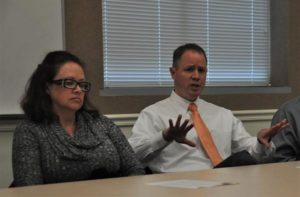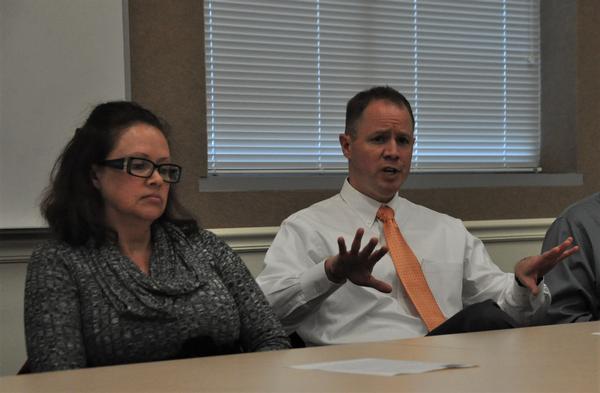 Tracy Hurtt was surprised by her first few months as a civilian. Before retiring as a sergeant first class in 2013, her whole life had revolved around the military, first as a family member then as a soldier.
Tracy Hurtt was surprised by her first few months as a civilian. Before retiring as a sergeant first class in 2013, her whole life had revolved around the military, first as a family member then as a soldier.
“I struggled with not belonging to something that was bigger than I was,” she said about her retirement. “I wanted to continue to serve.”
In 2014, Hurtt was recruited by the Naval Air Systems Command (NAVAIR) Veteran and Wounded Warrior Program and today is the deputy Integrated Product Team lead for Marine Aviation Logistics-Enterprise Information. “Because of the program, I am still able to contribute,” she said.
Hurtt shared her experiences and perspectives at “Warrior to Workforce – A Personal Story of Transition Challenges and Successes,” a forum sponsored by the NAVAIR Individuals With Disabilities Action Team (IWDAT) Nov. 13 along with five other veterans who found employment at NAVAIR through its Veteran and Wounded Warrior Program.
The program focuses on providing employment opportunities to honorably discharged veterans who have a compensable service-connected disability of 30 percent or more resulting from injury or disease received in the line of duty as a direct result of armed conflict.
Locksley, who is an executive champion of the IWDAT, said the experience veterans have at NAVAIR sends a positive message on the value of military service. “President George Washington said, ‘The willingness with which our young people are likely to serve in any war, no matter how justified, shall be directly proportional to how they perceive the veterans of earlier wars were treated and appreciated by their nation.’
“That still rings true today,” Locksley said.
“Since the inception of the NAVAIR Wounded Warrior Program in October 2010, more than 3,000 wounded warriors have been placed at NAVAIR, making invaluable contributions to its mission every day,” he said. The program has since evolved to the NAVAIR Veteran and Wounded Warrior Program which is an outreach initiative for all veterans seeking NAVAIR career opportunities.
As a result of their training and discipline, wounded warriors bring an unparalleled tenacity and heightened commitment to teamwork, explained Precision Strike Weapons (PMA-201), Naval Acquisition Development Program (NADP) life cycle logistics intern, Ryan Daniels, a wounded warrior and speaker at the event. “There are some characteristics of leadership you can’t learn without being in the service first. It pairs well with NAVAIR,” he said.
These qualities, however, are difficult to document in a résumé. Many veterans find translating their experiences to in-demand skills daunting, according to Logistics and Industrial Operations Warrior Integration and Support Program Manager Sonny Fann. “Veterans have diverse backgrounds that often don’t align with what NAVAIR does,” he said. “Hiring managers and supervisors need to look a bit deeper for transitional skill sets that wounded warrior candidates offer and find alignment with NAVAIR position requirements. The greatest value veterans bring to any organization are their personal attributes such as mission orientation, leadership ability, critical thinking skills and life experiences.”
For instance, Fann explained, a master sergeant’s skills include leading and managing diverse groups in extremely complex situations to accomplish a mission. “A master sergeant has the ability to apply his or her experience to a position like a program manager or operations officer. The challenge is not just the jobs on the résumé, but understanding the experience behind the job and how it relates to a position,” Fann said.
The NAVAIR Veteran and Wounded Warrior Program is a much-needed bridge for veterans, according to Joseph Okrasinski, a speaker at the event. In 2005, he was in one of the first groups to retire early after Operation Iraqi Freedom. “The support was not in place so there was little guidance. We had to find employment on our own. I saw the complexity of the hiring process and the difficulties other veterans went through,” he said.
His greatest concern was transitioning from the military—he didn’t know how to take his skills and apply them to a civilian job. Okrasinski ultimately pursued a career in human resources and is now serves in the Total Force Strategy and Management Department at NAVAIR.
Philip Seale, a wounded warrior who is currently a NADP life cycle logistics intern on rotation at U.S. Marine Corps Light/Attack Helicopter Program (PMA-276), also spoke on the challenges of applying his experience as an infantryman to a civilian job during the first months of his retirement. “I had difficulty landing my first job after leaving the Army because I didn’t capture all of my skills on a résumé,” he explained. “You have to ‘peel back the onion’ to reveal your qualifications.”
Hiring managers and supervisors can also help wounded warriors make successful transitions to civilian employment. “Supervisors can seek to understand each person’s situation and place the wounded warrior in a position of success,” Fann said. “That may include reasonable accommodations, such as telework or other resources available through the NAVAIR Reasonable Accommodations Program Office.”
Providing opportunities for wounded veterans to serve after leaving the military is crucial in the work to reduce their suicide rates. More than 6,000 veterans took their lives each year between 2008 and 2016, according to the Department of Veterans Affairs, Veterans Health Administration, Office of Mental Health and Suicide Prevention’s Veteran Suicide Data Report, 2005–2016, Updated September 2018. “Our organization is not about recruiting people, but about saving lives,” explained Fann. “Many wounded warriors struggle physically. The difficulties impact not only them, but their families as well. We help them understand that they are not alone.”
“Wounded warriors have pride and valor,” Locksley said. “They want to make a positive contribution to society. Most of all, they want to provide for themselves and their family. It’s a win-win for the command and for veterans. These veterans are examples of that.”

Philip Seale (right) tells participants to take advantage of every opportunity that presents itself. Tracy Hurtt is also pictured.


